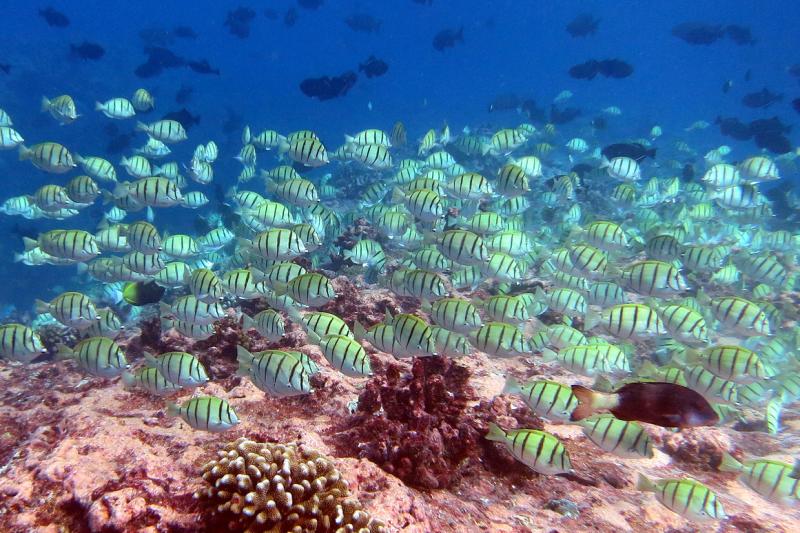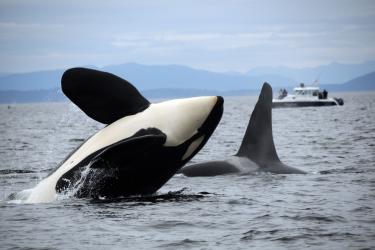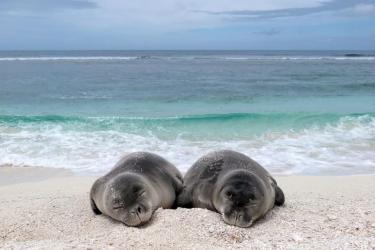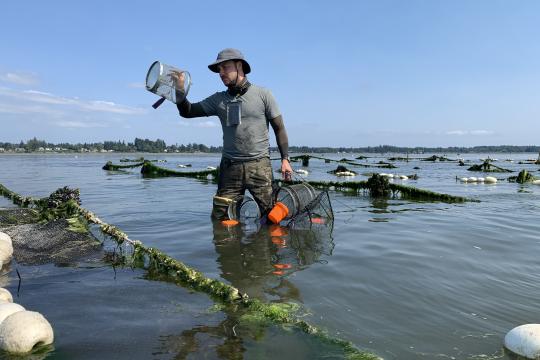May is Asian American Pacific Islander Heritage Month, which pays tribute to generations of Asian and Pacific Islanders who have enriched our nation's history and are instrumental to its future. Join us in celebrating this month by meeting some of our colleagues from coast to coast who help NOAA Fisheries ensure sustainable fisheries, conserve and recover protected species, conduct scientific research, and conserve important habitats.
From Bagoong of the Philippines to Korean Jogaetang, Seafood Connects NOAA Fisheries Staff
We asked NOAA Fisheries staff who identify as Asian American, Native Hawaiian, or Pacific Islander and who work in the West Coast region to share stories of their favorite seafood—from how it is harvested, prepared, or shared, to how it connects to their heritage.
For these staff members, seafood wasn't just a part of their diet. It was also a main ingredient in growing up and family traditions, and still remains a comfort today. Read their personal recollections about seafood, and consider supporting AANHPI-owned businesses when you shop for seafood or order your next meal!
Learn more about our staff and their connection to seafood
Jui-Han Chang, Research Biologist
Growing up in Taiwan, Jui-Han was surrounded by spectacular oceans and rugged mountains. Her father is an amateur ecologist and her mother is an environmental advocate, so it seemed she was destined for a career in science. But it took her a while to find her path.
Now she works at the Northeast Fisheries Science Center on multiple scallop-related projects, including data collection, stock assessment, climate change, and artificial intelligence. All of these things influence sea scallop management. She loves her work at the center because she's very passionate about fisheries science. Most importantly, it really excites her that the work she does has a real impact on marine resource management and sustainable fisheries.
Learn more about Jui-Han and her work
Dereka Chargualaf, Fish Biologist
As a fish biologist, Dereka Chargualaf's work is focused on estimating steelhead and rainbow trout densities and monitoring fish movement in the Carmel River and its tributaries. She captures and tags individuals with Passive Integrated Transponders tags and establish PIT-tag antenna arrays throughout the watershed. She is currently transitioning to NOAA’s California Coastal Office where she will be working as a Fish Biologist conducting Endangered Species Act consultations.
Her fieldwork has been located in the Carmel River and its tributaries from the headwaters upstream of the Los Padres Dam to the Carmel River Lagoon. In her new role, she will be conducting work throughout California’s coastal watersheds. Dereka grew up on Guam, which is the southernmost island of the Mariana Archipelago and the westernmost territory of the United States.
Learn more about Dereka Chargualaf and her work
Lisa Hiruki-Raring, Education and Outreach Coordinator
As an Education and Outreach Coordinator at the Alaska Fisheries Science Center, Lisa translates the research that NOAA Fisheries scientists do into educational activities or resources.
Lisa began her career conducting research on Hawaiian monk seals at the NOAA Fisheries lab in Honolulu, which inspired her to pursue a Master’s degree in zoology. She worked for the Pacific Islands Fisheries Science Center in Honolulu for a few years, studying population dynamics of Hawaiian monk seals. Then she moved to Seattle to work in the Alaska Fisheries Science Center’s Marine Mammal Laboratory. First she worked on Antarctic fur seals, and later on harbor seals and ice-associated seals in Alaska. Finally, she moved into education and outreach coordination. She believes communicating about our science is a way to give back to the communities where we do research. This type of outreach focuses on all levels of education, from K-12 to undergraduate internships to graduate fellowship opportunities. She also provides informal education opportunities to the general public about our agency, what we do, and why it matters.
Learn more about Lisa Hiruki-Raring and her work
Kristen Koyama, National Endangered Species Recovery Coordinator
Kristen Koyama grew up on the west side of Los Angeles, California near the ocean. The ocean was always a presence in her life and she visited the beach on weekends. However, she still struggled to connect to the natural world even though she was fascinated by it. Living in an urban area made her seek out nature more, and her interest in marine science and the ocean continued throughout her education and career.
Kristen's interest in nature led her to a multifaceted career in ecology, public policy, and international conservation issues. Today, she plays an important role at NOAA Fisheries as the national recovery coordinator for species listed as threatened or endangered under the Endangered Species Act.
Learn more about Kristen Koyama and her work
Peter Kuriyama, Research Mathematic Statistician
Peter Kuriyama grew up in Solana Beach, California and lists his parents and grandparents as strong influences in his life. Today he works as a research mathematical statistician with the NOAA Southwest Fisheries Science Center. He works on stock assessments for coastal pelagic species, which helps inform fisheries management on the west coast of the United States.
Peter got his undergraduate degree at UC Santa Barbara and his Ph.D. at University of Washington. His dissertation examined the impact of catch share implementation on the U.S. West Coast groundfish fishery.
Learn more about Peter Kuriyama and his work
Joel Moribe, Endangered Species Biologist
Joel Moribe is an endangered species biologist for the Pacific Islands Regional Office, based out of O‘ahu, Hawai‘i. He works on Section 7 consultations, natural resource program coordination, acoustics, effects analysis, effect minimization, and species protection.
With more than 20 years of experience as a marine scientist, Joel is an Endangered Species Act expert, fueled by a passion to prevent species from going extinct and to put together strategies to recover their populations. Before coming to the Pacific Islands Region, he spent 14 years in the Pacific Northwest conducting project analysis for the protection of salmon and killer whales. He also spent 3 years with the Navy as an endangered species project manager. In addition to all of that, he conducts fieldwork when he can.
Learn more about Joel Moribe and his work
Fatima Sauafea-Le’au, Fisheries Biologist
As a fisheries biologist based in Pago Pago, American Samoa, one of Fatima's primary roles is to serve as a fisheries liaison for coral reef management. She provides support and assistance to the American Samoa resource management partners and local communities on coral reef management projects. She also helps staff conduct reviews and consultations on development projects in American Samoa for Essential Fish Habitat.
Fatima is a Samoan, born and raised in American Samoa. She grew up in a small village called Aua on Tutuila Island in a family that values culture, church, and family. She earned a B.S. degree in biology from Chaminade University in Honolulu, Hawai‘i and an M.S. degree in Environmental Policy and Management from the University of Denver.
Learn more about Fatima Sauafea-Le’au and her work
Judy Yaqin Li, Research Ecologist
Judy Yaqin Li grew up in Ningbo, China, a coastal city close to the most productive fisheries in China called Zhoushan Islands. Various kinds of seafood like fish, shellfish, squids, and even jellyfish were caught around these islands and were the main protein source for her family. She remembers going to the beach after school to catch crabs, snails, and other beach creatures at low tide and waiting to buy fresh seafood just unloaded from the fishing boats.
As a research ecologist, Judy conducts aquaculture and environmental research with her capable, talented, and fun colleagues at the Milford Laboratory. Their research contributes to the understanding of shellfish aquaculture in the context of the environment and it helps promote healthy and sustainable fisheries and their ecosystems. She's proud to apply her knowledge and skills from her education and work experiences to aquaculture and fisheries research, whether it be related to shellfish, seaweed, and even salmon restoration.














